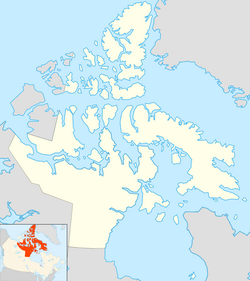Kimmirut
|
Kimmirut ᑭᒻᒥᕈᑦ |
|
|---|---|
| Hamlet | |

Kimmirut, Nunavut
|
|
| Coordinates: 62°50′48″N 069°52′07″W / 62.84667°N 69.86861°WCoordinates: 62°50′48″N 069°52′07″W / 62.84667°N 69.86861°W | |
| Country | Canada |
| Territory | Nunavut |
| Region | Qikiqtaaluk Region |
| Electoral district | South Baffin |
| Anglican mission | 1909 |
| Government | |
| • Mayor | Maliktoo Lyta |
| • MLA | David Joanasie |
| Area | |
| • Total | 2.27 km2 (0.88 sq mi) |
| Elevation | 53 m (174 ft) |
| Population (2016) | |
| • Total | 389 |
| • Density | 171.7/km2 (445/sq mi) |
| Time zone | EST (UTC-5) |
| • Summer (DST) | EDT (UTC-4) |
| Canadian Postal code | X0A 0N0 |
| Area code(s) | 867 |
| Website | www.kimmirut.ca |
Kimmirut (Syllabics: ᑭᒻᒥᕈᑦ IPA: [kimːiɢut]; known as Lake Harbour until 1 January 1996) is a community in the Qikiqtaaluk Region, Nunavut, Canada. It is located on the shore of Hudson Strait on Baffin Island's Meta Incognita Peninsula. Kimmirut means "heel", and refers to a rocky outcrop in the inlet.
It was at one time a Hudson's Bay Company trading post, and a Royal Canadian Mounted Police post. The Canadian explorer J. Dewey Soper used these posts as headquarters during his explorations in the 1920s and 1930s.
The community is served by Kimmirut Airport and by annual supply sealift. A proposal in 2005 for a road to Iqaluit was shown to be impractical owing to roundabout routing over the mountains.
As of the 2016 census the population was 389, a decrease of 14.5% from the 2011 census
Boat launch in Kimmirut. The "heel" can be seen to the left. 2006
Hudson's Bay Company in Lake Harbour, 1922
Hudson's Bay Company, 2006
The Soper House dates back to the 1930s. 2006.
View of Kimmirut, 2006
Kimmirut has an Arctic climate (Köppen: ET), although it is well outside the Arctic Circle. The city has cold winters and short summers that are too cool to permit the growth of trees. It is north of the tree line, and average monthly temperatures are below freezing for eight months of the year. Kimmirut averages just over 335 mm (13.2 in) of precipitation annually, wetter than many other localities in the Canadian Arctic Archipelago, with the summer being the wettest season.
...
Wikipedia

